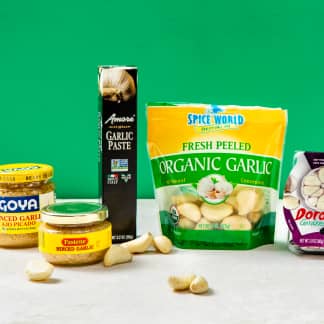Anchovies can transform a dish. And I’m not just talking about the salty-savory magic that happens when you scatter a few fillets over a pizza. Like soy sauce, miso, and other umami-rich ingredients, cured anchovies are powerful supporting players. In addition to bumping up the salt level of a dish, they add complexity and unique, concentrated savoriness. We call for cured anchovies in many recipes, including pizza sauce, turkey meatballs, and whole roasted cauliflower.


Cooking meatballs or roasting vegetables? Adding minced anchovies adds lots of savory depth.
Given the big role these little fish play in our recipes, we decided to give them a closer look. We purchased 11 products in a variety of styles—including anchovies packed in oil, anchovies packed in salt, and anchovy paste—and sampled them plain and in Caesar dressing. Then, we compared the three top scorers in each category in a puttanesca recipe.
How Are Anchovies Cured and Packaged?
Most anchovies are harvested from the Mediterranean Sea and the waters off the coasts of Argentina and Peru. The method for cleaning and curing them goes back centuries and is still done mostly by hand. The fish are beheaded and gutted and then carefully layered in barrels or drums with lots of salt. After weights are placed on top of the containers, the fish are cured for anywhere from three to 12 months. The salt draws moisture from the fish, creating a brine; the salt also helps break down the fish and preserves them. The cured fish are then rinsed and dried to remove excess salt and water.

The timing of each step is important. Anchovies are high in fat, so they can quickly oxidize and spoil if they’re not cleaned and cured shortly after they’re caught. A representative from Musco Foods, which imports anchovies for the Merro brand, explained that the size of the anchovies and the temperature of the curing room determine how long the fish need to cure. In general, shorter curing times are preferable because the fish doesn’t break down too much and stays pleasantly plump.

When the curing process is complete, some anchovies are then packed in containers with fresh salt. Others are filleted first and then packed in containers with oil. Still others are pureed into a paste and sold in tubes.
The Science Behind Anchovies’ Flavor
Although the anchovy-curing process is fairly straightforward, a lot happens inside those barrels and drums. Enzymes from different parts of the fish generate flavor components and, as the food science writer Harold McGee explains in On Food and Cooking (1984), the warm environment encourages the creation of aromatic molecules. The result is “remarkably full flavor” that McGee describes as including “fruity, fatty, fried, cucumbery, floral, sweet, buttery, meaty, popcorn, mushroom, and malty notes.” We often think of anchovies as tasting simply savory and salty or briny, but the top scorers in our tastings were incredibly nuanced, with subtle sweetness, hints of “oak,” and pleasant “funk.”
How to Shop for Anchovies
Our top-rated products were all oil-packed anchovies, but there is a strong case for considering salt-packed anchovies and anchovy paste. Which style is right for you depends on how much prep you're willing to do and the amount of anchovy flavor you prefer. For this reason, we named a winner in each style.
Oil-Packed Anchovies: Our All-Around Favorite
The best oil-packed anchovies are firm, meaty, and glossy, with a “buttery” richness. They have a subtle sweetness and nuanced, deeply savory flavor that adds depth to dishes without tasting overwhelmingly fishy.

How to Prepare Them: These anchovies are filleted prior to packaging and can be used straight from the container. Unless a recipe specifies that they need to be rinsed, simply pat them dry to remove excess oil. You may notice small, whisker-like bones in oil-packed anchovies; they are delicate enough to easily slice or bite through.
How to Store Them: They can be stored in the refrigerator for months. If you purchase anchovies in a tin, transfer them to a clean glass jar that seals tightly.
Our Favorites: We liked every product we tried, but we were really impressed by Merro Flat Fillets of Anchovies in Pure Olive Oil ($2.05 per ounce) and Ortiz Anchovies in Olive Oil ($4.24 per ounce).
Salt-Packed Anchovies: The Anchovy-Lover’s Delight
Salt-packed anchovies are assertive: They’re drier, and it’s easier to pinpoint a distinctive “anchovy-y” flavor when you cook with them. Some tasters liked that bold “untamed” flavor, but people who are ambivalent about anchovies will likely be happier with oil-packed anchovies or anchovy paste.

How to Prepare Them: These anchovies require a little prep work before they can be used. After they’re removed from the salt, they must be rinsed, dried, and filleted to remove their spines and to separate them into two pieces.

How to Store Them: Salt-packed anchovies are generally sold in large tins or plastic tubs. If the original container cannot be resealed tightly, we suggest transferring the anchovies to a glass food storage container. Take care to re-cover the remainder with salt, as exposure to air can cause them to oxidize and develop off-flavors or spoil. Store them in the refrigerator.
Our Favorites: We liked both of the products we tried. Agostino Recca Anchovies in Salt ($0.96 per ounce) and Scalia Italian Anchovies in Salt ($0.72 per ounce) come in large containers—about 27 ounces compared with about 2 or 3 ounces for oil-packed anchovies—which means that you spend more up front but save on the per-ounce price.
Anchovy Paste: Most Convenient Option
Anchovy paste is less complex and has milder anchovy flavor than either salt-packed or oil-packed anchovies, which is good for people looking to add just a subtle briny savoriness to dishes. It’s made by pureeing anchovies with salt and oil (usually sunflower oil or a mix of sunflower and olive oils).

How to Prepare It: No prep is necessary. Simply squeeze the paste into a measuring spoon and move on with the recipe.
How to Store It: Open tubes can be stored in the refrigerator for months.
Our Favorite: Pastes tend to taste quite salty (one was criticized as being more of a “salt paste”), so we recommend seeking out our favorite. Scalia Anchovy Paste in Tube ($2.00 per ounce) is a great option for people who don’t want the hassle of mincing anchovies by hand and prefer a milder, less noticeable anchovy flavor.
- Sample plain
- Sample in Caesar dressing
- Compare the top-scoring oil-packed anchovies, salt-packed anchovies, and anchovy paste in puttanesca sauce
- Calculate the amount of sodium per 15-gram serving size (approximately 1 tablespoon minced)
- Samples were randomized and assigned three-digit codes to prevent bias
- Deeply savory flavor
- Not overwhelmingly salty
- For tinned and jarred fish: firm, meaty texture and intact fish






















